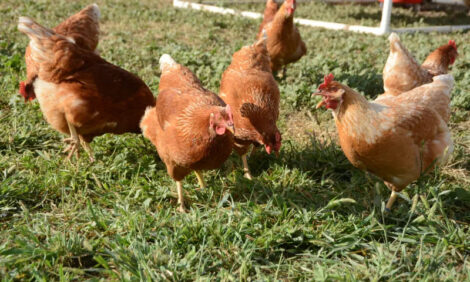



Clostridial Dermatitis on US Turkey-Grower Farms
Clostridial dermatitis is an emerging condition in turkeys and broilers in the US, with around 40 per cent of turkey grower farms reporting some issues. It was more common and more severe in the central region and in summer and autumn/fall, according to a report from the USDA Animal and Plant Health Inspection Service (APHIS). Poor farm hygiene and high house humidity appeared to be linked to outbreaks and the case for the involvement of Clostridium septicum was strengthened by the findings of the study.Clostridial dermatitis (cellulitis/gangrenous dermatitis) is a disease of turkeys and broilers and has increased in severity over the last several years, according to a new report.
In 2010, the US Animal Health Association (USAHA) ranked clostridial dermatitis among the top three disease issues in turkeys (USAHA, 2010).
Dermatitis can be associated with Staphylococcus aureus or Escherichia coli but recently, Clostridium spp. have been associated specifically with clostridial dermatitis.
Skin lesions associated with clostridial dermatitis appear necrotic, with oedema and/or gas in the underlying subcutaneous tissue. Sudden death is a frequent presentation of this illness (Clark et al., 2010).
Disease pathogenesis for clostridial dermatitis is poorly understood. The disease is believed to be caused by hematogenous transmission of clostridium from the gastrointestinal tract to muscle and skin where bacterial toxins are produced. Previous studies have suggested that bird density, litter conditions, and hygiene are potential risk factors for disease (Clark et al., 2010).
Clostridia are commonly found in the environment and intestines of healthy birds.
Controlling clostridial dermatitis is difficult because managing the growth of clostridia is challenging, especially during the birds’ growth phase. Uncontrolled growth of clostridia can result in toxin production, which causes disease. The basic components for controlling clostridial dermatitis include:
- reducing the number of clostridial microorganisms in birds and the environment, and
- augmenting bird immunity (Clark et al., 2010).
The clostridial dermatitis component of the US Department of Agriculture’s National Animal Health Monitoring System (NAHMS) Poultry 2010 study had three phases and was conducted to:
- estimate the prevalence of clostridial dermatitis on turkey grower farms in the United States
- identify risk factors for clostridial dermatitis outbreaks on turkey-grower farms, and
- to understand better the relationship between intestinal pathology, shedding of clostridial organisms, and disease occurrence.
Prevalence Estimate
Overall, 42.3 per cent of turkey-grower farms had at least a slight problem with clostridial dermatitis during the 12 months prior to the study.
No turkey-grower farms in the West region had clostridial dermatitis problems. In the Central region, 48.4 per cent of farms had some degree of disease, and 17.6 per cent had severe disease.

Case-control
Companies that participated in the prevalence phase of the study and had farms located in the Central and East regions selected farms for participation in the case-control phase.
Case farms were more severely affected by clostridial dermatitis during summer and fall – eight out of 10 had moderate or severe problems – than during spring or winter, when six out of 10 farms had moderate or severe problems.
Case farms were more likely than control farms to compost litter within 200 feet of a poultry barn (33 and six per cent, respectively) and
less likely to require employees to scrub footwear (23 and 72 per cent, respectively).
In addition, case farms had significantly higher humidity levels in the poultry barns than control farms and higher soil pH.
Clostridial dermatitis tends to be a disease of late finisher birds. However, disease problems appeared to be more severe in flocks in which disease onset occurred when birds were less than 13 weeks of age than with flocks with older birds. A lower percentage of flocks on case farms were moderately or severely affected when birds’ water was acidified, or when direct-fed microbials were administered.

Pathology
Seven companies participated in this phase of the study. Nineteen case farms were visited weekly during the weeks leading up to an anticipated outbreak. Six control farms were visited weekly during the same period. Samples were collected for culture and histopathology. Sixteen case farms had clostridial dermatitis outbreaks, while three case farms and all six control farms had no outbreaks during the study.
Prior to an outbreak, birds on outbreak farms and non-outbreak farms had similar prevalence of Clostridium septicum (one per cent of birds). About half the birds (42 per cent) were positive for C. septicum during an outbreak. Approximately 20 per cent of birds were
positive for C. perfringens, regardless of outbreak status.

C. septicum was found in liver and spleen samples, which is consistent with the theory of hematogenous spread to muscle. C. perfringens was found less commonly in internal organs.
More than half the birds sampled during an outbreak had gross lesions consistent with clostridial dermatitis in the skin/subcutaneous tissue/muscle but lesions were rarely seen before an outbreak. Intestinal pathology was frequently found, especially in the lamina propria and muscle of the ileum and Meckel’s diverticulum, on both outbreak and non-outbreak farms.
Intestinal pathology did not appear to be related to outbreak status.
Two-thirds of C. septicum-positive birds (67 per cent) had gross lesions consistent with clostridial dermatitis compared with less than one-tenth of C. septicum-negative birds.
There was no substantial difference in the percentage of C. perfringens-positive birds and C. perfringens-negative birds with lesions. C. septicum- and C. perfringens-positive birds had no more intestinal pathology than C. septicum- and C. perfringens-negative birds.
C. septicum was found on 22 per cent of non-outbreak farms and on 87 per cent of outbreak farms. C. perfringens was found on more than 80 per cent of farms, regardless of outbreak status.
References
Clark S., Porter R., McComb B., Lippert R., Olson S., Nohner S. and Shivaprasad H.L. 2010. Clostridial dermatitis and cellulitis: an emerging disease of turkeys. Avian Dis. 54(2):788–794.
USAHA. 2010. Transmissible diseases of poultry report.
Further ReadingYou can view the full report by clicking here.Find out more information on clostridial dermatitis by clicking here. |
September 2012








